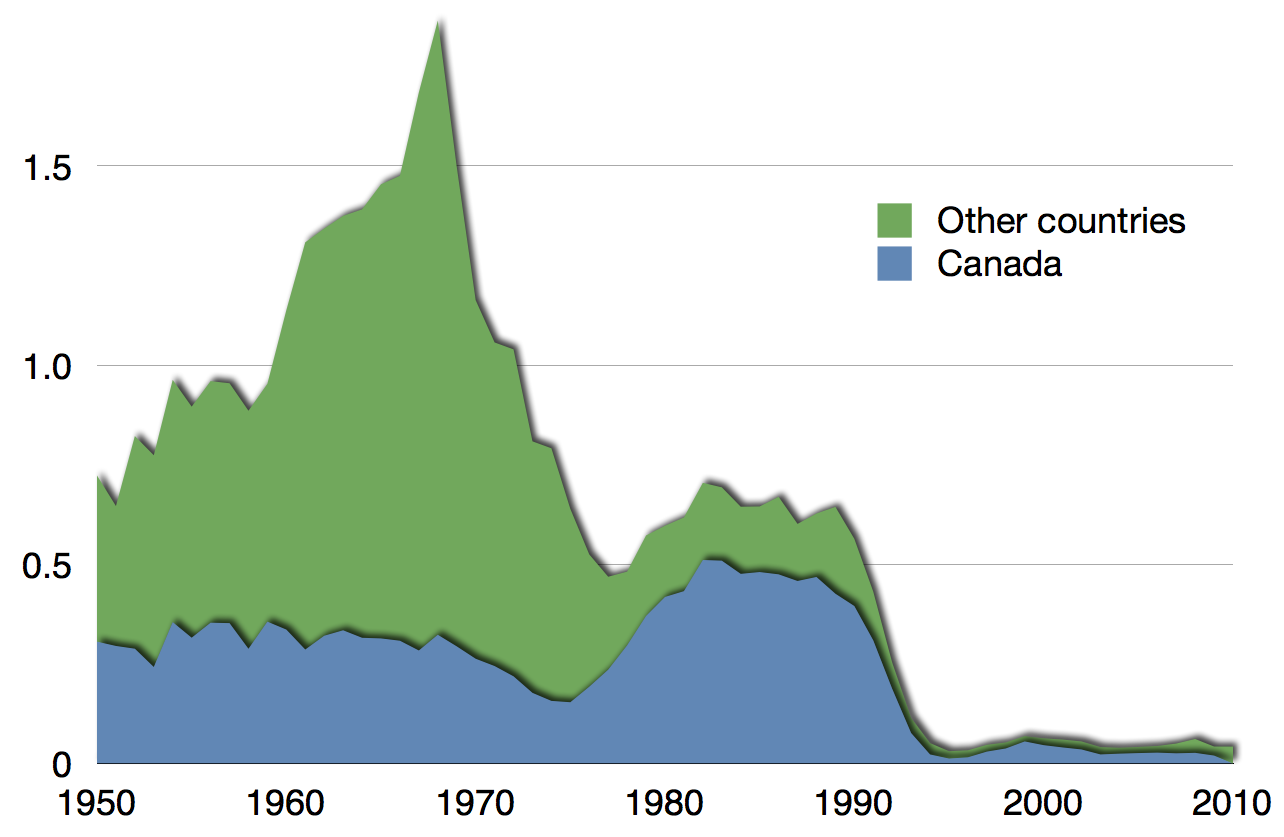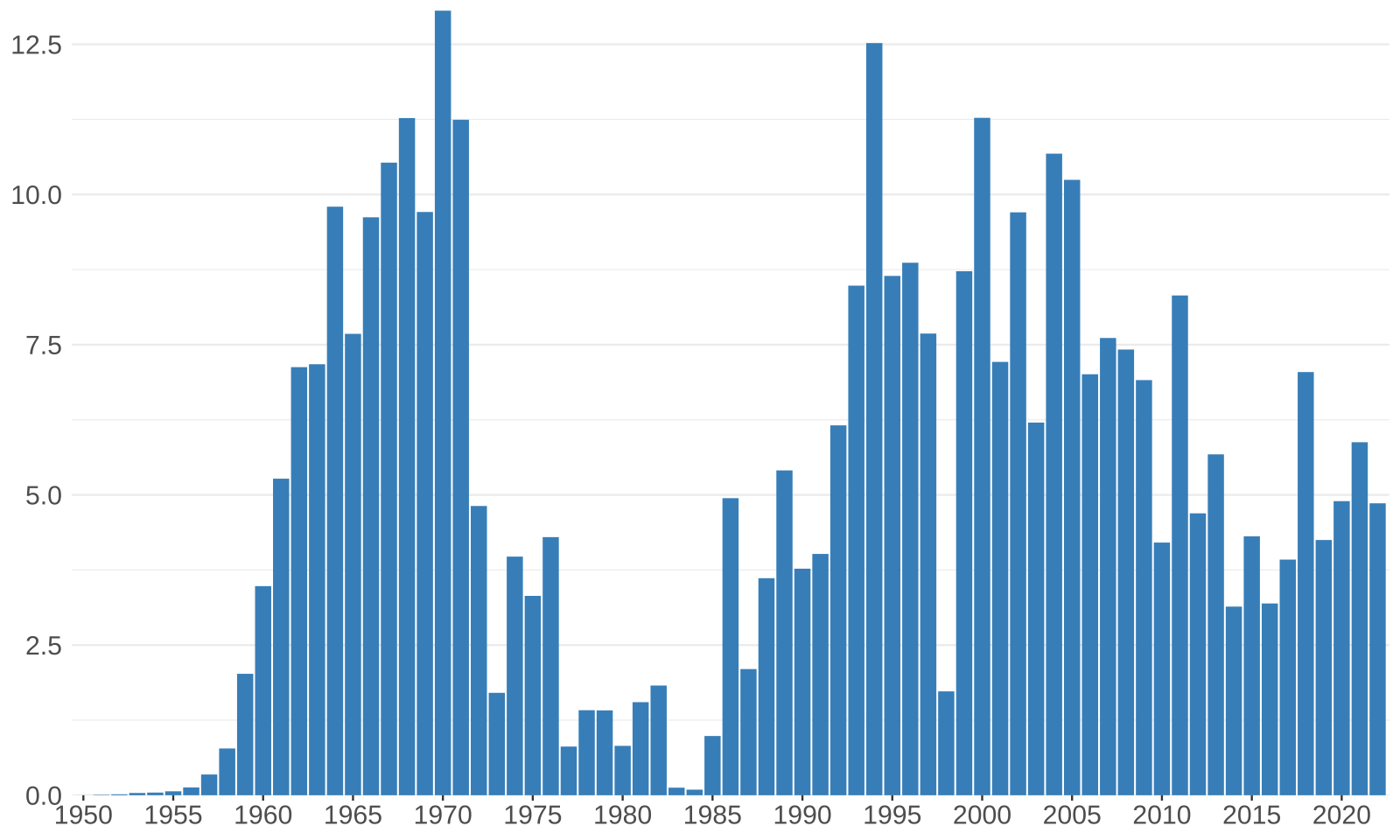IB Syllabus focus:
‘Overexploitation can crash stocks beyond recovery (e.g., Grand Banks cod), disrupting ecosystems and livelihoods.’
Fishery collapses are dramatic events in which once-productive aquatic systems fail due to overexploitation, causing ecological imbalance, economic hardship, and long-lasting consequences for global food security.
Understanding Fishery Collapses
A fishery collapse occurs when a fish stock is reduced to levels where it can no longer recover naturally, often due to sustained overfishing, poor management, or environmental stressors.
Fishery Collapse: A rapid, severe decline in a fish population to levels too low to sustain viable harvest or natural replenishment.
The collapse is not just about the disappearance of a species from commercial exploitation but represents a breakdown of an entire ecological and socio-economic system.
Ecological Consequences
When a stock collapses, the effects ripple across the ecosystem. Key consequences include:
Trophic cascades: Removing a key species destabilises predator-prey relationships, leading to overpopulation of some species and scarcity of others.
Loss of biodiversity: Genetic diversity declines as species numbers fall, making ecosystems less resilient to future changes.
Habitat degradation: Destructive fishing practices often harm seabeds and coral reefs, reducing the capacity for recovery.
Example: Grand Banks Cod
The collapse of the Grand Banks cod fishery in the early 1990s demonstrates how unsustainable fishing effort, combined with poor regulatory enforcement, pushed stocks below recovery thresholds. Despite fishing moratoria, cod numbers have never fully rebounded, illustrating the concept of irreversible ecosystem change.

Time-series plot of Atlantic northwest cod catches highlighting the early-1990s collapse, with Canadian landings shown separately. The trend visualises how sustained overfishing precipitated a stock crash with protracted recovery—central to the ecological and livelihood impacts discussed. Source.
Socio-economic Consequences
Fishery collapses severely impact human societies, particularly those reliant on aquatic resources.
Loss of livelihoods: Millions of people depend on fisheries for income. Collapse leads to unemployment and migration.
Food insecurity: Fish is a major protein source worldwide; reduced supply increases pressure on other food systems.
Economic decline: Coastal communities experience long-term economic contraction when industries linked to fisheries—such as processing and shipping—shrink or vanish.
Food Security: Reliable access to sufficient, safe, and nutritious food to support a healthy life.
Fishery collapses can undermine food security at both local and global scales, particularly in developing nations where fish protein is essential.
Irreversibility and Recovery Barriers
Some fisheries never recover because of biological and ecological thresholds. Key barriers include:
Allee effect: Populations fall so low that reproduction is insufficient to rebuild numbers.
Shifts in ecosystem structure: New dominant species prevent former stocks from regaining their niches.
Genetic bottlenecks: Reduced gene pools limit adaptability to environmental changes.
Overexploitation and Feedback Loops
Overfishing intensifies as stocks dwindle, because:
Rarer fish increase market value, creating economic incentives to continue exploitation.
Fishers invest in more advanced technologies to capture remaining stocks, accelerating decline.
This creates a positive feedback loop where exploitation drives further depletion.
Broader Environmental Impacts
Fishery collapses have implications beyond the targeted species:
Carbon cycling disruption: Declines in large fish alter nutrient flows and carbon storage in oceans.
Reduced ecosystem services: Fisheries contribute to regulating ecosystems and cultural values; collapse weakens these services.
Increased reliance on aquaculture: While aquaculture can replace some supply, it introduces new environmental pressures such as pollution, disease, and habitat loss.
Human Dimensions and Governance
Fishery collapses highlight governance failures. Many occur due to:
Lack of scientific management: Absence of data or disregard for stock assessments.
Political pressures: Short-term economic gains prioritised over long-term sustainability.
Weak enforcement: Illegal, unreported, and unregulated fishing undermines quotas and recovery plans.
International Conflicts
Shared waters, such as high seas fisheries, often lack cooperative management. This leads to tragedy of the commons, where each nation maximises harvest without responsibility for long-term consequences.
Tragedy of the Commons: A situation where individuals exploit a shared resource for short-term benefit, depleting it to the detriment of all users.
Case Study Significance
The Grand Banks cod collapse is one of the most cited examples, but similar events have occurred globally:
Peruvian anchoveta: A key fishery collapsed in the 1970s due to overfishing and El Niño events, leading to loss of the world’s largest fishery at that time.

Global capture of Peruvian anchoveta (Engraulis ringens) with a pronounced early-1970s crash corresponding to overfishing and El Niño conditions. Although the figure spans 1950–2022 (extra detail), it clearly marks the collapse discussed in the syllabus-aligned notes. Source.
Pacific salmon runs: Collapsed due to overharvest, dam construction, and habitat alteration, reducing both cultural and ecological significance.
Each case highlights how fishery collapses result from interacting human and environmental pressures, not just fishing intensity alone.
Preventing Future Collapses
To avoid repeating these failures, global management must focus on:
Precautionary quotas: Setting catch limits below maximum sustainable yield to allow stock recovery.
Ecosystem-based management: Considering food webs, habitats, and climate interactions, not just target species.
Marine Protected Areas (MPAs): Establishing no-take zones to safeguard breeding populations and restore stocks.
Community-based monitoring: Involving local stakeholders in management decisions to enhance compliance and long-term stewardship.
By recognising the ecological, social, and economic consequences, it becomes clear that fishery collapses are not isolated failures but systemic breakdowns with long-lasting global implications.
FAQ
Technological improvements, such as sonar, satellite navigation, and more efficient trawling equipment, allow fishers to locate and capture stocks more effectively.
While these tools increase short-term yields, they often accelerate the rate at which fish populations decline. This can push stocks beyond sustainable limits, particularly when combined with weak regulatory oversight.
Many coastal communities rely on fisheries not only for income but also as part of cultural identity, festivals, and generational livelihoods.
When fisheries collapse, traditional practices such as local fishing techniques, recipes, and communal activities often decline or disappear, causing cultural loss alongside economic hardship.
Reversing a collapse is difficult due to multiple biological and ecological factors:
Populations may fall below reproductive thresholds.
Ecosystem shifts favour new species that block recovery.
Genetic diversity is reduced, limiting adaptability.
Even with strict protection, these combined effects often prevent stocks from returning to former levels.
Climate events such as El Niño can alter ocean temperature, currents, and nutrient availability.
These shifts reduce plankton productivity, affecting food chains and weakening fish stocks already stressed by overexploitation. If fishing continues at high levels during these conditions, collapse becomes more likely.
Monitoring combines ecological and economic indicators:
Falling catch per unit effort (CPUE).
Declining average size of fish landed.
Reduced spawning biomass in surveys.
Economic signals such as rising prices due to scarcity.
Regular scientific assessments and transparent reporting are critical for detecting and acting on these warning signs before a collapse occurs.
Practice Questions
Question 1 (2 marks)
Define the term fishery collapse and identify one ecological consequence of such a collapse.
Mark scheme:
1 mark for a correct definition: a severe decline in a fish population to levels too low to sustain viable harvest or natural replenishment.
1 mark for an ecological consequence, e.g. trophic cascades, loss of biodiversity, or habitat degradation.
Question 2 (5 marks)
Using a named example, explain two socio-economic consequences of a fishery collapse.
Mark scheme:
1 mark for correctly naming an example (e.g. Grand Banks cod, Peruvian anchoveta).
Up to 2 marks for describing the first socio-economic consequence (e.g. loss of livelihoods, food insecurity, economic decline).
Up to 2 marks for describing the second socio-economic consequence.
Answers must show clear links between the collapse and the identified socio-economic impacts to gain full marks.

